stop start Lexus CT200h 2015 (in English) Owner's Guide
[x] Cancel search | Manufacturer: LEXUS, Model Year: 2015, Model line: CT200h, Model: Lexus CT200h 2015Pages: 634
Page 164 of 634

CT200h_OM_OM76174U_(U)
1634-2. Driving procedures
4
Driving
*: For good fuel economy and noise reduction, the D position should usually be used.
→P. 2 3 1
■When shifting the shift position to P
Fully stop the vehicle and set the
parking brake, and then press the P
position switch.
When the shift position is changed to
P, the switch indicator comes on.
Check that the P position is illumi-
nated on the shift position indicator.
■Shifting the shift position from P to other positions
●While depressing the brake pedal firmly, operate the shift lever. If the shift
lever is operated without depressing the brake pedal, the buzzer will sound
and the shifting operation will be disabled.
●When selecting the shift position, make sure that the shift position has been
changed to the desired position by checking the shift position indicator
provided on the instrument cluster.
●The shift position cannot be ch anged from P to B directly.
Shift position purpose
Shift positionObjective or function
PParking the vehicle/starting the hybrid system
RReversing
NNeutral
(Condition in which the power is not transmitted)
DNormal driving*
BApplying engine braking or strong braking when the accelera- tor pedal has been released on steep downward slopes etc.
Selecting a driving mode
P position switch
Page 233 of 634
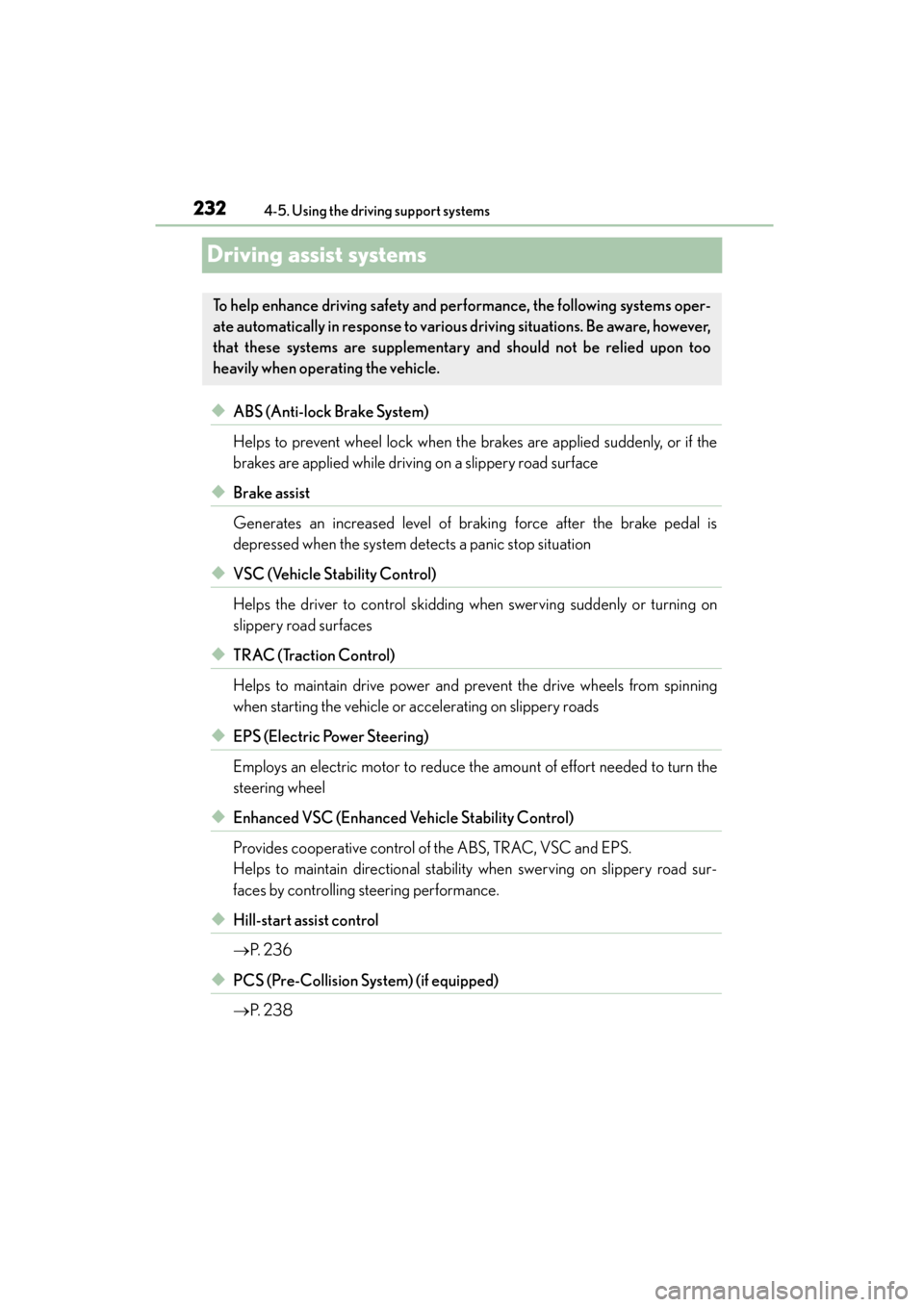
232
CT200h_OM_OM76174U_(U)4-5. Using the driving support systems
Driving assist systems
◆ABS (Anti-lock Brake System)
Helps to prevent wheel lock when the brakes are applied suddenly, or if the
brakes are applied while driving on a slippery road surface
◆Brake assist
Generates an increased level of braking force after the brake pedal is
depressed when the system detects a panic stop situation
◆VSC (Vehicle Stability Control)
Helps the driver to control skidding when swerving suddenly or turning on
slippery road surfaces
◆TRAC (Traction Control)
Helps to maintain drive power and prevent the drive wheels from spinning
when starting the vehicle or accelerating on slippery roads
◆EPS (Electric Power Steering)
Employs an electric motor to reduce the amount of effort needed to turn the
steering wheel
◆Enhanced VSC (Enhanced Vehicle Stability Control)
Provides cooperative control of the ABS, TRAC, VSC and EPS.
Helps to maintain directional stability when swerving on slippery road sur-
faces by controlling steering performance.
◆Hill-start assist control
→
P. 2 3 6
◆PCS (Pre-Collision System) (if equipped)
→P. 2 3 8
To help enhance driving safety and performance, the following systems oper-
ate automatically in response to various driving situations. Be aware, however,
that these systems are supplementary and should not be relied upon too
heavily when operating the vehicle.
Page 234 of 634
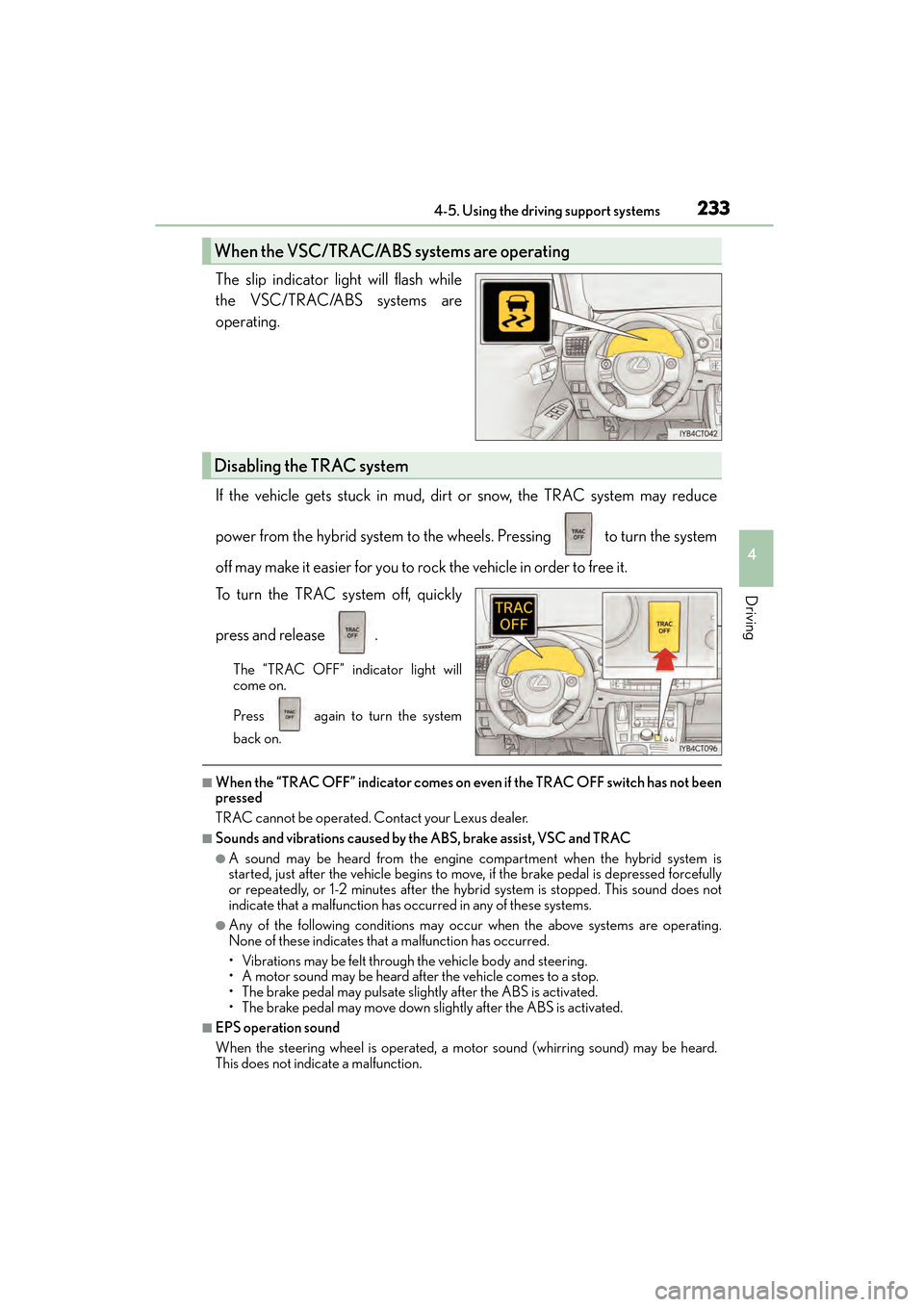
CT200h_OM_OM76174U_(U)
2334-5. Using the driving support systems
4
Driving
The slip indicator light will flash while
the VSC/TRAC/ABS systems are
operating.
If the vehicle gets stuck in mud, dirt or snow, the TRAC system may reduce
power from the hybrid system to the wheels. Pressing to turn the system
off may make it easier for you to rock the vehicle in order to free it.
To turn the TRAC system off, quickly
press and release .
The “TRAC OFF” indicator light will
come on.
Press again to turn the system
back on.
■When the “TRAC OFF” indicator comes on even if the TRAC OFF switch has not been
pressed
TRAC cannot be operated. Contact your Lexus dealer.
■Sounds and vibrations caused by the ABS, brake assist, VSC and TRAC
●A sound may be heard from the engine compartment when the hybrid system is
started, just after the vehicle begins to move, if the brake pedal is depressed forcefully
or repeatedly, or 1-2 minutes after the hybrid system is stopped. This sound does not
indicate that a malfunction has occurred in any of these systems.
●Any of the following conditions may occur when the above systems are operating.
None of these indicates that a malfunction has occurred.
• Vibrations may be felt through the vehicle body and steering.
• A motor sound may be heard after the vehicle comes to a stop.
• The brake pedal may pulsate slightly after the ABS is activated.
• The brake pedal may move down slightly after the ABS is activated.
■EPS operation sound
When the steering wheel is operated, a motor sound (whirring sound) may be heard.
This does not indicate a malfunction.
When the VSC/TRAC/ABS systems are operating
Disabling the TRAC system
Page 237 of 634

236
CT200h_OM_OM76174U_(U)4-5. Using the driving support systems
Hill-start assist control
To engage hill-start assist control, fur-
ther depress the brake pedal when the
vehicle is stopped completely.
A buzzer will sound once to indicate the
system is activated
. The slip indicator
will also start flashing.
■Hill-start assist control operating conditions
●The system operates in the following situations:
• The shift position is in a position other than P.
• The parking brake is not applied.
• The accelerator pedal is not depressed.
●Hill-start assist control cannot be operated while the slip indicator light is illuminated.
■Hill-start assist control
●While hill-start assist control is operating, the brakes remain automatically applied after
the driver releases the brake pedal. The stop lights and the high mounted stoplight turn
on.
●Hill-start assist control operates for about 2 seconds after the brake pedal is released.
●If the slip indicator does not flash and the buzzer does not sound when the brake pedal
is further depressed, slightly reduce the pressure on the brake pedal (do not allow the
vehicle to roll backward) and then firmly de press it again. If the system still does not
operate, check if the operating conditions explained above have been met.
Assists with starting off and temporarily maintains braking power even if the
foot is removed from the brake pedal when starting off on an incline or a slip-
pery slope.
Page 245 of 634
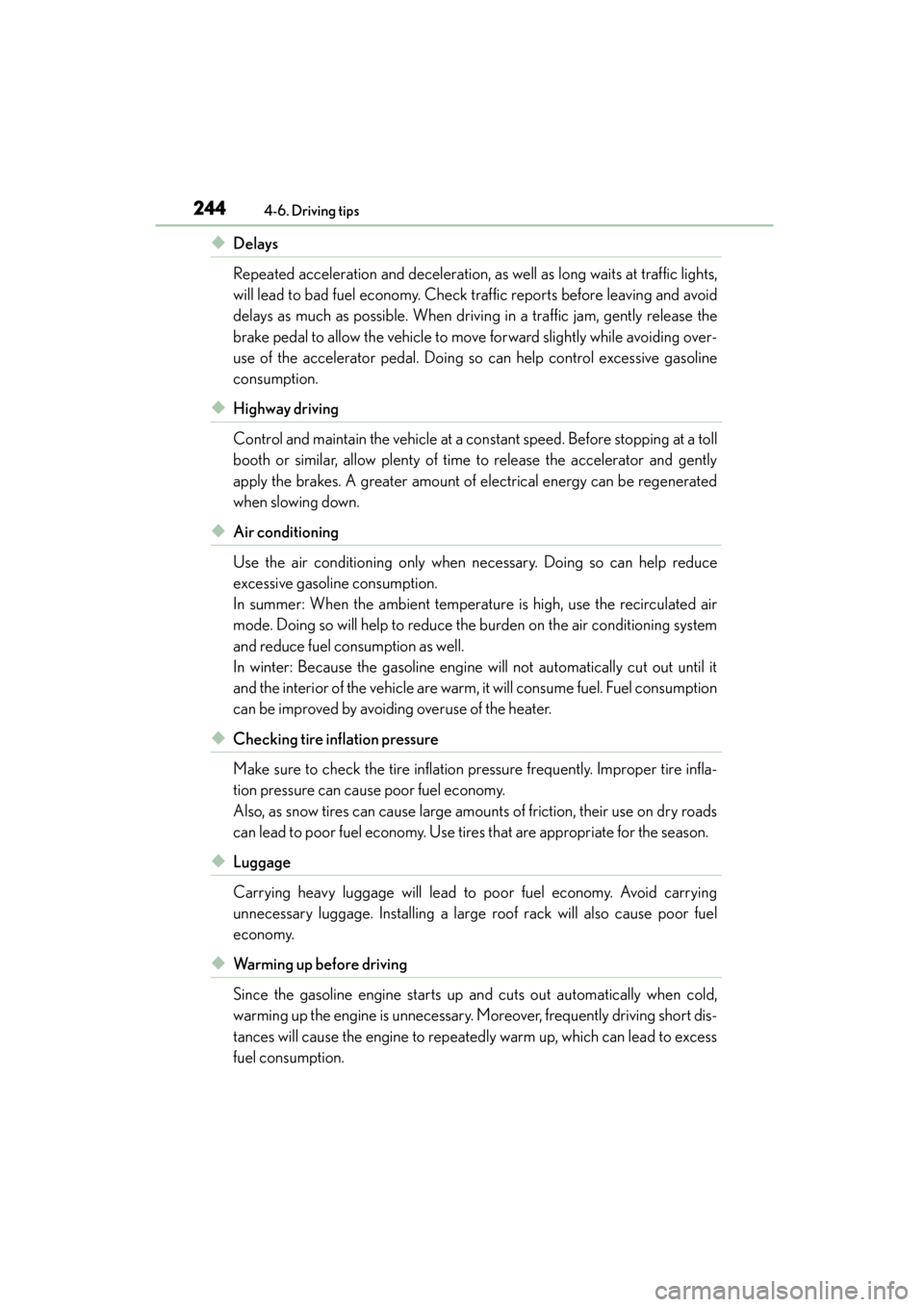
244
CT200h_OM_OM76174U_(U)4-6. Driving tips
◆Delays
Repeated acceleration and deceleration, as well as long waits at traffic lights,
will lead to bad fuel economy. Check
traffic reports before leaving and avoid
delays as much as possible. When drivin g in a traffic jam, gently release the
brake pedal to allow the vehicle to move forward slightly while avoiding over-
use of the accelerator pedal. Doing so can help control excessive gasoline
consumption.
◆Highway driving
Control and maintain the vehicle at a cons tant speed. Before stopping at a toll
booth or similar, allow plenty of time to release the accelerator and gently
apply the brakes. A greater amount of electrical energy can be regenerated
when slowing down.
◆Air conditioning
Use the air conditioning only when necessary. Doing so can help reduce
excessive gasoline consumption.
In summer: When the ambient temperature is high, use the recirculated air
mode. Doing so will help to reduce the burden on the air conditioning system
and reduce fuel consumption as well.
In winter: Because the gasoline engine will not automatically cut out until it
and the interior of the vehicle are warm, it will consume fuel. Fuel consumption
can be improved by avoiding overuse of the heater.
◆Checking tire inflation pressure
Make sure to check the tire inflation pressure frequently. Improper tire infla-
tion pressure can cause poor fuel economy.
Also, as snow tires can cause large amounts of friction, their use on dry roads
can lead to poor fuel economy. Use tires that are appropriate for the season.
◆Luggage
Carrying heavy luggage will lead to poor fuel economy. Avoid carrying
unnecessary luggage. Installing a large roof rack will also cause poor fuel
economy.
◆Warming up before driving
Since the gasoline engine starts up and cuts out automatically when cold,
warming up the engine is unnecessary. Moreover, frequently driving short dis-
tances will cause the engine to repeatedly warm up, which can lead to excess
fuel consumption.
Page 390 of 634
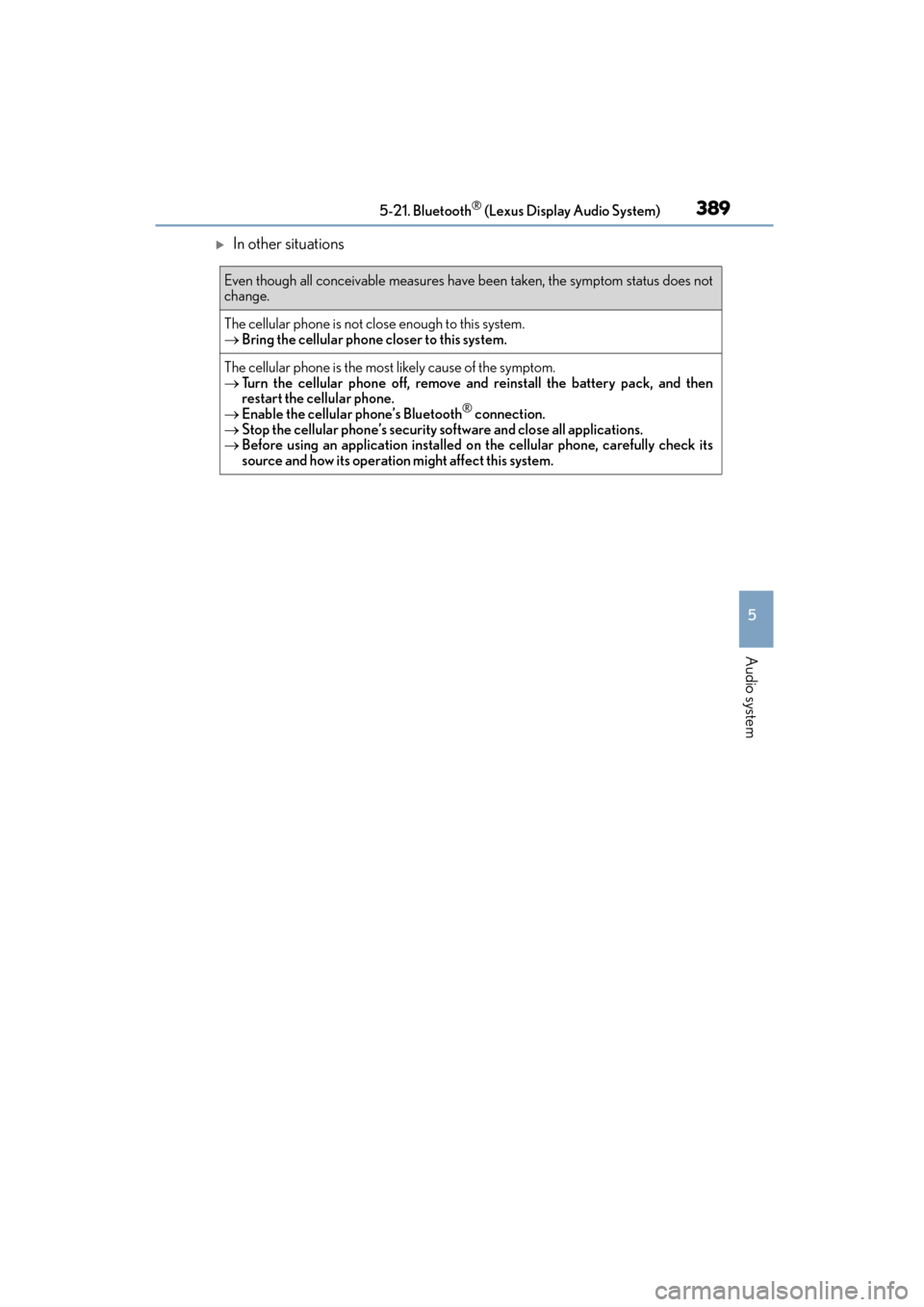
CT200h_OM_OM76174U_(U)
3895-21. Bluetooth® (Lexus Display Audio System)
5
Audio system
�XIn other situations
Even though all conceivable measures have been taken, the symptom status does not
change.
The cellular phone is not close enough to this system.
→Bring the cellular phone closer to this system.
The cellular phone is the most likely cause of the symptom.
→Turn the cellular phone off, remove and reinstall the battery pack, and then
restart the cellular phone.
→ Enable the cellular phone’s Bluetooth
® connection.
→ Stop the cellular phone’s security so ftware and close all applications.
→ Before using an application installed on the cellular phone, carefully check its
source and how its operation might affect this system.
Page 445 of 634

444
CT200h_OM_OM76174U_(U)6-4. Using the other interior features
Press and hold the programmed
HomeLink® button (located
inside the vehicle) for 2 seconds
and release it. Repeat this
sequence (press/hold/release)
up to 3 times to complete pro-
gramming.
If the garage door opener motor
activates when the HomeLink® but-
ton is pressed, the garage door
opener motor recognizes the
HomeLink
® signal.
■Enabling 2-way communication with a ga rage door (only available for com-
patible devices)
When enabled, 2-way communication allows you to check the status of the
opening and closing of the garage door through indicators in your vehicle.
2-way communication is only available if the garage door opener motor used
is a compatible device. (To check device compatibility, refer to the Owner’s
manual supplied with the garage door opener motor.)
Press a programmed HomeLink
® button to operate a garage door.
Within 1 minute of pressing the HomeLink
® button, after the garage door
operation has stopped, press the “learn” or “smart” button on the garage
door opener motor. Within 5 seconds of the establishment of 2-way com-
munication with the garage door opener, both garage door operation indi-
cators in the vehicle will flash rapidly (green).
■Reprogramming a single HomeLink® button
When the following procedure is performed, buttons which already have
devices registered to them can be overwritten: With one hand, press and hold the desired HomeLink
® button.
When the HomeLink
® indicator starts flashing, continue to hold the
HomeLink® button and perform “Programming HomeLink®” from step
(it takes 20 seconds for the HomeLink® indicator to start flashing).
3
1
2
1
2
1
Page 520 of 634

519
CT200h_OM_OM76174U_(U)
8When trouble arises
8-1. Essential informationEmergency flashers .................. 520
If your vehicle has to be stopped in an
emergency...................................521
8-2. Steps to take in an emergency
If your vehicle needs to be towed ..................................... 522
If you think something is wrong ........................................... 526
If a warning light turns on or a warning buzzer
sounds.......................................... 527
If a warning message is displayed..................................... 534
If you have a flat tire................... 547
If the hybrid system will not start ............................................... 557
If the electronic key does not operate properly ..................... 559
If the 12-volt battery is discharged ...................................561
If your vehicle overheats ......... 565
If the vehicle becomes stuck ............................................. 569
Page 529 of 634
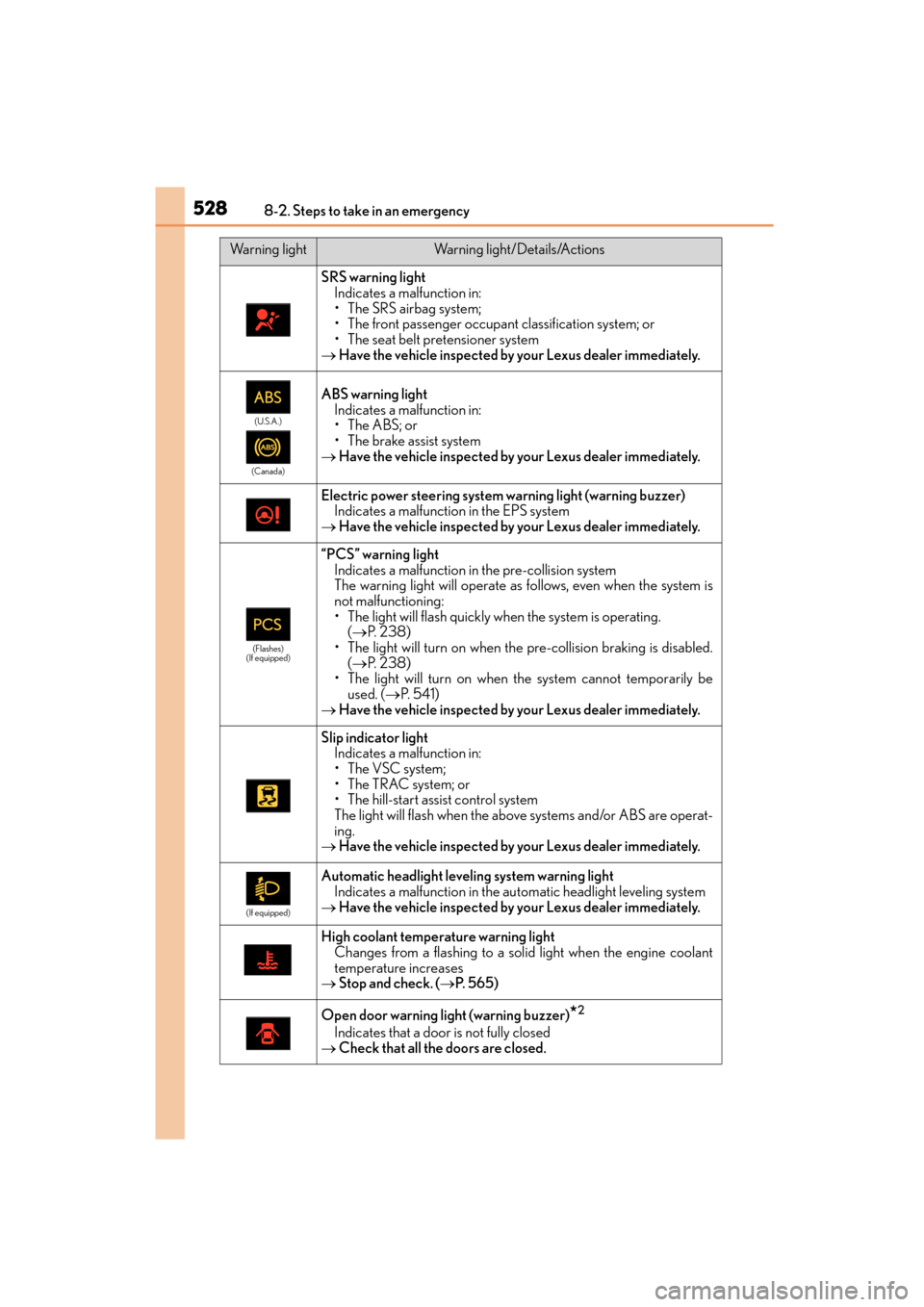
5288-2. Steps to take in an emergency
CT200h_OM_OM76174U_(U)
SRS warning lightIndicates a malfunction in:
• The SRS airbag system;
• The front passenger occupant classification system; or
• The seat belt pr etensioner system
→ Have the vehicle inspected by your Lexus dealer immediately.
(U.S.A.)
(Canada)
ABS warning light Indicates a malfunction in:
•The ABS; or
• The brake assist system
→ Have the vehicle inspected by your Lexus dealer immediately.
Electric power steering system warning light (warning buzzer)
Indicates a malfunction in the EPS system
→ Have the vehicle inspected by your Lexus dealer immediately.
(Flashes)
(If equipped)
“PCS” warning light Indicates a malfunction in the pre-collision system
The warning light will operate as follows, even when the system is
not malfunctioning:
• The light will flash quickly when the system is operating. (→ P. 2 3 8 )
• The light will turn on when the pre-collision braking is disabled. (→ P. 2 3 8 )
• The light will turn on when the system cannot temporarily be
used. ( →P. 5 4 1 )
→ Have the vehicle inspected by your Lexus dealer immediately.
Slip indicator light
Indicates a malfunction in:
• The VSC system;
•The TRAC system; or
• The hill-start assist control system
The light will flash when the abov e systems and/or ABS are operat-
ing.
→ Have the vehicle inspected by your Lexus dealer immediately.
(If equipped)
Automatic headlight leveling system warning light
Indicates a malfunction in the au tomatic headlight leveling system
→ Have the vehicle inspected by your Lexus dealer immediately.
High coolant temperature warning light
Changes from a flashing to a solid light when the engine coolant
temperature increases
→ Stop and check. ( →P. 5 6 5 )
Open door warning light (warning buzzer)*2
Indicates that a door is not fully closed
→ Check that all the doors are closed.
Warning lightWarning light/Details/Actions
Page 534 of 634

5338-2. Steps to take in an emergency
CT200h_OM_OM76174U_(U)
8
When trouble arises
WA R N I N G
■Maintenance of the tires
Each tire, including the spare (if provided), should be checked monthly when cold and
inflated to the inflation pressure recommended by the vehicle manufacturer on the
vehicle placard or tire inflation pressure label (tire and load information label). (If your
vehicle has tires of a different size than the size indicated on the vehicle placard or tire
inflation pressure label [tire and load in formation label], you should determine the
proper tire inflation pressure for those tires.)
As an added safety feature, your vehicle has been equipped with a tire pressure moni-
toring system (TPMS-tire pressure warning system) that illuminates a low tire pressure
telltale (tire pressure warning light) when on e or more of your tires is significantly
under-inflated. Accordingly, when the low ti re pressure telltale (tire pressure warning
light) illuminates, you should stop and check yo ur tires as soon as possible, and inflate
them to the proper pressure. Driving on a significantly under-inflated tire causes the
tire to overheat and can lead to tire failure. Under-inflation also reduces fuel efficiency
and tire tread life, and may affect the vehicle’s handling and stopping ability.
Please note that the TPMS (tire pressure warning system) is not a substitute for proper
tire maintenance, and it is the driver’s responsibility to maintain correct tire pressure,
even if under-inflation has not reached the level to trigger illumination of the TPMS low
tire pressure telltale (tire pressure warning light).
Your vehicle has also been equipped with a TPMS (tire pressure warning system) mal-
function indicator to indicate when the system is not operating properly. The TPMS
(tire pressure warning system) malfunction indicator is combined with the low tire pres-
sure telltale (tire pressure warning light). When the system detects a malfunction, the
telltale will flash for approximately one minu te and then remain continuously illumi-
nated. This sequence will continue upon su bsequent vehicle start-ups as long as the
malfunction exists. When the malfunction indicator is illuminated, the system may not
be able to detect or signal low tire pressure as intended.
TPMS (tire pressure warning system) malfunctions may occur for a variety of reasons,
including the installation of replacement or alternate tires or wheels on the vehicle that
prevent the TPMS (tire pressure warning system) from functioning properly. Always
check the TPMS (tire pressure warning syst em) malfunction telltale after replacing one
or more tires or wheels on your vehicle to ensure that the replacement or alternate
tires and wheels allow the TPMS (tire pressure warning system) to continue to function
properly.
NOTICE
■To ensure the tire pressure warning system operates properly
Do not install tires with different specifications or makers, as the tire pressure warning
system may not operate properly.